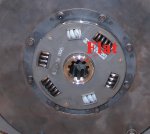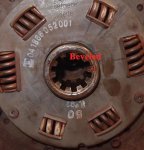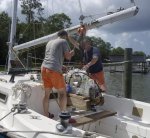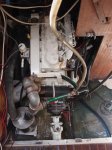I've got a V1902, just rebuilt. It seems to be working well, except for two issues.
Issue #1:
There is air in my return lines, but does not appear to affect engine; it runs. The fuel injector has a bleeder valve and when that valve is closed, air bubbles accumulate in the return hoses on both sides of each injector. When I open the bleeder valve, fuel pushes the air back to the tank. Air does not exist in the hose that goes from the bleeder valve to the first injector. I temporarily replaced the return tubes between injectors with clear tube so I could see where air is coming from.
Engine recently rebuilt, injector pump recently rebuilt. With engine off, but elec. fuel pump running, no air accumulates in return hoses; it only happens when engine is running. The higher the rpm, the more air. I've tightened the fuel injection pipes. Any ideas where the air is coming from?
Possible problem #2:
When I turn the engine manually, I hear a creaking noise coming somewhere at the rear of the engine. I can also feel the creaking in several places (crank shaft, water hoses, transmission housing). I don't recall this being present until the first run after the rebuild (which was yesterday).
Here is a link to pictures and video of the air bubbles as well as a video of the creaking.
http://bodylens.com/engine/
Creaking video shows the front of the engine, but the noise is coming from the rear of the engine, down low.
Thanks
Edit: Regarding creaking. It sounds like an impeller running dry, but there is no impeller in that part of the engine. Also, when cranking by hand (like in the video), I can reverse direction and hear no creaking for about 1/4 turn, then creaking resumes.
Issue #1:
There is air in my return lines, but does not appear to affect engine; it runs. The fuel injector has a bleeder valve and when that valve is closed, air bubbles accumulate in the return hoses on both sides of each injector. When I open the bleeder valve, fuel pushes the air back to the tank. Air does not exist in the hose that goes from the bleeder valve to the first injector. I temporarily replaced the return tubes between injectors with clear tube so I could see where air is coming from.
Engine recently rebuilt, injector pump recently rebuilt. With engine off, but elec. fuel pump running, no air accumulates in return hoses; it only happens when engine is running. The higher the rpm, the more air. I've tightened the fuel injection pipes. Any ideas where the air is coming from?
Possible problem #2:
When I turn the engine manually, I hear a creaking noise coming somewhere at the rear of the engine. I can also feel the creaking in several places (crank shaft, water hoses, transmission housing). I don't recall this being present until the first run after the rebuild (which was yesterday).
Here is a link to pictures and video of the air bubbles as well as a video of the creaking.
http://bodylens.com/engine/
Creaking video shows the front of the engine, but the noise is coming from the rear of the engine, down low.
Thanks
Edit: Regarding creaking. It sounds like an impeller running dry, but there is no impeller in that part of the engine. Also, when cranking by hand (like in the video), I can reverse direction and hear no creaking for about 1/4 turn, then creaking resumes.
Last edited:





